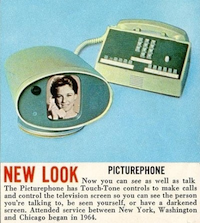
AT&T Picturephone
It’s been a long standing journalistic practice that when writing about the failure of yet another video phone product, you march out AT&T’s Picturephone launch at the 1964 New York World’s Fair. I believe it’s a pretty safe bet that Apple’s new FaceTime will break the long losing streak of this concept and make video chats as natural and popular as, well, a cell phone call. Even though we finally have a video phone winner, it’s still instructive to look at that early Bell product, if only to understand why it will take a company like Apple to make it a mass success.
AT&T gets credit for pushing the idea of a two-way video conversation back in the 1960s. They understood that this intrusive technology meant a loss of privacy, but thought it would be counterbalanced by the public’s just-under-the-surface narcissism. Their original advertising slogan was “Some Day You’ll be A Star” (see P. Coburn’s, The Change Function). This was a bold call to arms for a pre-Internet, pre-Facebook, and pre-Youtube America.
The prototype was actually developed years earlier (1956) at Bell Labs. What AT&T put on display in its exhibition hall was a clunky black-and-white CRT tethered to a push-button phone. The picture was small, the control knobs were difficult to work, and the picture refreshed at a painstakingly slow rate.
When AT&T introduced Picturephone service between New York and Chicago at $21 per minute, there were few takers. This did not stop Ma Bell from predicting millions of Picturephone users by the 1980s.
Of course, this never happened, and success in the business world, where it made some sense, was limited. AT&T eventually dropped the Picturephone.
With the iPhone, Apple has the advantage of building on incredible leaps in technology—multi-touch LCD screen, powerful video and CPU chips, long life Li batteries, and the Internet—along with massive societal changes in the way technology is perceived (see social networking software). Besides being limited by the electronics of the day, the Picturephone was hamstrung by low-bandwidth analog lines.
But even after the technology caught up in the 1990s, video conferencing had still not lived up to its earlier expectations—though it has made solid headway in business environments.
It took mobile phones and the Internet to break the association between a phone number and place. With iPhone 4, a video call just becomes a casual interaction that doesn’t have to take place in front of a bulky device (by the way, today’s corporate room video conferencing system is an elephant on wheels) at a specific location: it’s perfect for our on-the-run, 140-character mass culture.
And the iPhone 4 is more than just a phone, unlike the original Picturephone. When you’re done with a video chat, you can still use the Apple wonder gadget for information, navigation, games, movies, maps, and on and on. Like what Apple did with Xerox’s personal computer technology, the iPhone is an irresistible bundle of software and hardware that you continually find new uses for.
Chris Dixon (of Hunch) has a good article about how Apple and Steve Jobs broke the monopoly the carriers had on the mobile market. Now finally, you pick the phone first, and then you find the carrier.
There are still a lot of questions about FaceTime— the specs, the APIs—but by all account the thing works flawlessly.
The big question is whether the AT&T 3G network will be able to handle the video traffic. (Currently, FaceTime works on WiFi only.)
It looks like weak link, as it was in the 1960s, is still AT&T.
Related articles by Zemanta
- WWDC: Video Calling on iPhone 4 With FaceTime: Wi-Fi Only (gigaom.com)
- Apple iPhone 4 – first look (telegraph.co.uk)
- Steve Jobs Single-Handedly Restructured The Mobile Industry (businessinsider.com)
- The Change Function: Why Some Technologies Take Off and Others Crash and Burn (Pip Coburn)
- What Apple’s FaceTime app means for Skype (textually.org)



Nice bit of history here. But can’t agree with your “Now finally, you pick the phone first, and then you find the carrier”. How do I do that with the Iphone or almost any other phone except Nokia (and Nexus one)?
It’s beginning to happen outside the US. O2, Orange, T-Mobile, and Vodafone will all be offering the iPhone in the UK starting next week. In the less-than-competitive US market, there may still be a chance we’ll see a t-mobile iphone 4 soon. In any case, since this is a gadget that carriers clearly want on their network, the iphone 4 is as close to a future-proof investment as is possible in the mobile environment.